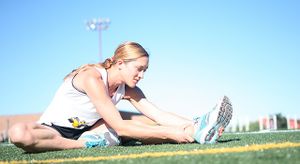Purpose
Stretching exercises have traditionally been included as part of a training and recovery program. Evidence shows that physical performance in terms of maximal strength, number of repetitions and total volume are all affected differently by the each form of stretching – static stretch (SS), dynamic stretch (DS) and Pre-contraction stretching, Proprioceptive Neuromuscular Facilitation stretching (PNFS) being the most common type.[1][2]
Stretching can help improve flexibility and range of motion about your joints. Improved flexibility may: Improve your performance in physical activities; Decrease your risk of injuries; Help your joints move through their full range of motion; Enable your muscles to work most effectively[3]
Technique
Techniques of stretching include
Static Stretching
Static stretching (SS) is a type of stretching exercises in which elongation of muscle with application of low force and long duration (usually 30 sec). Static stretching has a relaxation, elongation effect on muscle, improving range of motion (ROM) , decreasing musculotendinous stiffness and also reduces the risk of acute muscle strain injuries.[4] It is a slow controlled movement with emphasis on postural awareness and body alignment. It is suitable for all patient types.[5]
Dynamic Stretching
Dynamic Stretching (DS) involves the performance of a controlled movement through the available ROM. DS involves progressively increasing the ROM through successive movements till the end of the range is reached ie the stretch is repetitive and progressive. DS is good to use in advanced sports related rehabilitation and active sports persons. DS helps restore dynamic function and neuromuscular control through repeating and practicing movement thus enhancing motor control. DS is sometimes considered preferable to SS in the preparation for physical activity.[6]
DS activities help elevate core temperature increasing: nerve conduction velocity; muscle compliance and enzymatic cycling; accelerating energy production. DS more likely increase rather than decrease central drive, as may occur with prolonged SS.[1]
Pre-Contraction Stretching
This form of stretching involves a contraction of the muscle being stretched or its antagonist before stretching. PNF is the most common type, see below. Other types of pre-contraction stretching include “post-isometric relaxation” (PIR). This type of technique uses a much smaller amount of muscle contraction (25%) followed by a stretch. Post-facilitation stretch (PFS) is a technique developed by Dr. Vladimir Janda that involves a maximal contraction of the muscle at mid-range (Figure 5) with a rapid movement to maximal length followed by a 15-second static stretch.
Proprioceptive Neuromuscular Facilitation Stretching (PNFS)
Multiple PNF stretching techniques exist, all of them rely on stretching a muscle to its limit. This triggers the inverse myotatic reflex, a protective reflex that calms the muscle to prevent injury. Regardless of technique, PNF stretching can be used on most muscles in the body. PNFS can also be modified so you can do them alone or with a partner.[7]
The types of PNF stretch techniques are listed below
- Contract Relax (CR) Contraction of the muscle through its spiral-diagonal PNF pattern, followed by stretch
- Hold Relax (HR) Contraction of the muscle through the rotational component of the PNF pattern, followed by stretch
- Contract-Relax Agonist Contract (CRAC) Contraction of the muscle through its spiral-diagonal PNF pattern, followed by contraction of opposite muscle to stretch target muscle
Ballistic Stretching
Ballistic stretching includes rapid, alternating movements or ‘bouncing’ at end-range of motion; however, because of increased risk for injury, ballistic stretching is no longer recommended.[2]
The below video gives a brief description of the types of stretching ( isometric stretching here is similar to PNFS)
Contraindications to Stretching
- Bony block on EOR on passive assessment
- Unstable/recent fracture
- Acute soft tissue injury
- Infection/haematoma in tissues
- Post surgical repairs eg skin grafts, tendon repair
- Client refusal
Evidence
A 2012 study on the evidence surrounding stretching techniques found that the benefits of stretching seem to be individual to the population studied. To increase ROM, all types of stretching are effective, although PNF-type stretching may be more effective for immediate gains. To avoid decrease in strength and performance that may occur in athletes due to static stretching before competition or activity, dynamic stretching is recommended for warm-up. Older adults over 65 years old should incorporate static stretching into an exercise regimen. A variety of orthopedic patients can benefit from both static and pre-contraction stretching.[2]
Physiotherapy- Important Messages To Remember for Stretching
- To increase joint range of motion, all types of stretching are effective, although PNF-type stretching may be more effective for immediate gains.
- Dynamic stretching is recommended for warm-up for athletes before competition or activity. As static stretching will likely decrease strength and may influence performance.[9]
- Post exercise static stretching or Proprioceptive Neuromuscular Facilitation stretching is recommended for reducing muscle injuries and increasing joint range of motion.[10] Although Stretching has not been shown to be effective at reducing the incidence of overall injuries.
- Stretching is often included in Physiotherapy interventions for management of many kinds of clinical injuries. Despite positive outcomes, it is difficult to isolate the effectiveness of the stretching component of the total treatment plan because the protocols usually include strengthening and other interventions in addition to stretching.[1]
References
- ↑ 1.01.11.2 POGO ↑ 2.02.12.2 Page P. ↑ Mayo Clinic ↑ Physiopedia Impact of static stretching on muscle performance Available from: https://www.physio-pedia.com/Impact_of_Static_Stretching_on_Performance (last accessed 1.6.2019)
- ↑ Kay AD, Blazevich AJ. ↑ Mason D Exercise in rehabilitation In: Porter S Tidy’s Physiotherapy Sydney Elsevier 2013 pages 281-284
- ↑ Healthline ↑ Rachael Goepper Types of stretching Available from: ↑ ↑ Sharman MJ, Cresswell AG, Riek S. function gtElInit() { var lib = new google.translate.TranslateService(); lib.setCheckVisibility(false); lib.translatePage('en', 'pt', function (progress, done, error) { if (progress == 100 || done || error) { document.getElementById("gt-dt-spinner").style.display = "none"; } }); }
Ola!
Como podemos ajudar?


